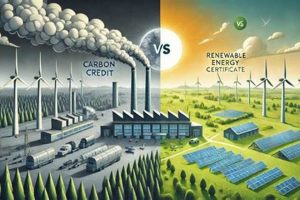
These tradable instruments represent the environmental attributes associated with electricity generated from solar energy systems. Each one signifies that a specific quantity of electricity, typically one megawatt-hour (MWh), has been produced by... Read more »

The State of Hawaii offers a substantial financial incentive for residents who invest in eligible renewable energy systems for their homes or businesses. This incentive takes the form of a credit against... Read more »

Representing one megawatt-hour (MWh) of electricity generated from eligible renewable sources within the state, these instruments serve as a tradable commodity. A wind farm, for example, generates electricity and receives one of... Read more »

One represents a permit allowing the emission of one metric ton of carbon dioxide or an equivalent greenhouse gas, often used to offset emissions. The other certifies that one megawatt-hour of electricity... Read more »

Tracking and managing the ownership of instruments representing renewable energy generation is crucial for regulatory compliance and market participation. These instruments, typically verified by a third-party entity, certify that a specific amount... Read more »

A financial instrument representing the environmental benefits of electricity generated from solar energy systems within the Commonwealth. For every megawatt-hour (MWh) of electricity a solar system produces, one of these credits is... Read more »

Federal incentives for residential clean energy upgrades are claimed using specific documentation for applicable tax years. For example, homeowners who install solar panels, geothermal heat pumps, or wind turbines may utilize designated... Read more »

State-level incentives for clean energy adoption in Hawaii take the form of deductions against individual and corporate income taxes for investments in eligible renewable energy technologies. These technologies often include solar water... Read more »

A financial instrument represents the environmental benefits of electricity generated from a solar power system within the service territory of Southern California Edison (SCE). These credits are created when a qualifying solar... Read more »

In California’s vibrant renewable energy market, tradable instruments representing proof of generation from eligible renewable sources play a crucial role. These instruments can be bought and sold, allowing electricity providers to demonstrate... Read more »


